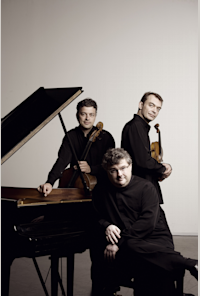The Chamber Music Cycle of Auditorio de Tenerife presents the concert Schumann y amigos (Schumann and friends) by Trío Wanderer.
Schumann and friends
1810 was the year of birth of some of the greatest geniuses in the history of music, including Schumann (1810), Mendelssohn (1809) and Liszt (1811), three maestros of romanticism who knew one another well and admired one another. And that is why romanticism itself will be the leitmotiv of this programme.
The Trío op. 63 by Schumann reveals the dark and tragic side of the composer. Incessant and intense chromaticisms collide in tumultuous explosions. In a strange passage played ponticello style, the celestial and angelic vision can be glimpsed that announces the schizophrenia that later took over Schumann. After the fantastic paseo of the Scherzo, the slow movement, Langsam, mit inniger Empfindung -with an intimate feeling- is a pinnacle of the Schumann´s poetry that links with the finale Mit Feuer -with fire- whose fresh exuberance dispels the gloom and anguish of night to finish in a flood of fire.
Schumann and Mendelssohn are masters of chamber music, but that is not the case with Liszt, although at the end of his life he composed a complete set of pieces, often short, for evenings with friends. This gave rise to some little wonders, which are little known, such as the two Elegies, Forgotten Romance, the Black Gondola, Die Zelle in Nonnenwerth.... For the trio, he left us with this magnificent Tristia. In 1870, a pupil of Liszt, Eduard Lassen produced a transcription of the famous piece for piano La Vallée d'Obermann, taken from the first book of the Years of Pilgrimage.
It wasn´t until much later, in 1880, that Liszt took charge of this transcription, completely recreating it, adding a strange and almost atonal introduction and finally renaming it as Tristia. An ode by Byron and a novel of the same name by Sénancour are Liszt´s two sources of inspiration for this work: "I live and die unheard, with a most voiceless thought, sheathing it as a sword", "What do I want? Who am I? What do I ask of nature?", these phrases taken from Childe Harold's Pilgrimage by Byron and Obermann by Sénancour, respectively, perfectly describe the vision and metaphysical questions that run through it.
“It is the trio par excellence of our age", is how Schumannn described the Trio op. 49 when he discovered the score of his friend Felix Mendelssohn. Far from the anguish and torment of the night, here everything is fresh and limpid, and the ardour, passion and tenderness combine in a unique formal perfection.
The chaotic and masterly first movement Molto Allegro Agitato is followed by an Andante that presents one of the most beautiful phrases in romantic music, a moment of grace and purity. The Scherzo, Mendelssohnesque in its magic and lightness, takes us into the world of A Midsummer Night´s Dream. As for the finale, a frenetic rustic rondo, it concludes this masterpiece of German romanticism in an extravagant and lively way.




